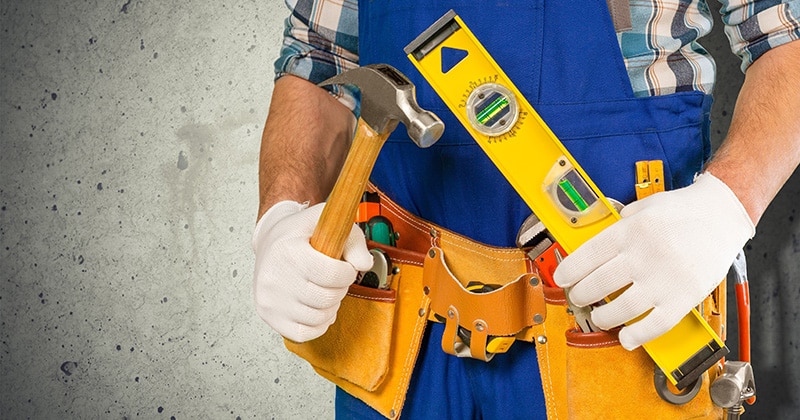Starting your own handyman business is an exciting opportunity to turn your skills into a profitable venture. But launching a successful business takes more than just tools and talent. Approximately 20% of small businesses fail in their first year, and nearly 50% fail within five years.
A well-organized handyman business startup checklist is essential for streamlining the process. It also ensures you’re set up for success.
One of the first steps is choosing the right business structure and securing a business name that represents your services. You’ll also need to apply for a business license and open a dedicated business bank account to keep your finances in order. Protecting yourself with job professional liability insurance is equally important, as it shields you from potential risks while on the job.
This guide will walk you through the key steps of building a solid foundation for your company. You’ll learn about making a plan on how to start a handyman business to gaining a deeper knowledge on the essentials of managing income and expenses. With the right preparation, you’ll be ready to grow it to a profitable handyman business.
By the end, you’ll have a clear path to launch your handyman business with confidence. So, grab your tools, roll up your sleeves, and let’s build your business from the ground up.
Setting the Foundation for a Successful Handyman Business
A solid foundation is the first step to creating a thriving handyman business. A startup checklist serves as a roadmap that guides you through the early stages of your setup and helps avoid common pitfalls.
Here’s why having a checklist is critical:
Streamlines the Business Setup Process
Juggling the steps involved in starting a business can feel overwhelming. This includes steps like business registration, setting up insurance, and organizing your services.
A checklist can help you break the process down into manageable tasks, ensuring nothing gets missed along the way. In fact, research shows that businesses with a written business plan grow 30% faster than those without one.
Sets Realistic Goals and Expectations
Knowing what lies ahead allows you to set clear short and long-term goals. Whether it’s reaching a certain number of clients or expanding your service area. Having a checklist helps you stay focused on what’s achievable. It also helps you understand achievable expectations for your business before creating one yourself.
Ensures Compliance with Local Regulations
From business licenses to permits, staying compliant with local laws is crucial for avoiding legal trouble.
A checklist guarantees that you’re ticking off all the necessary regulatory steps. So your business runs smoothly without risk of fines or penalties.
Helps Manage Startup Costs Effectively
Starting a handyman business comes with upfront costs, from buying tools to marketing. A detailed checklist helps you track your expenses. It also prevents overspending and ensures you stick to your budget.
Supports Marketing and Branding Efforts
Establishing an early marketing presence is vital for your brand. A checklist will help you organize your efforts. This includes creating a website, registering on local directories, and setting up social media profiles.
Provides a Roadmap for Future Growth
Whether you plan to expand your services or hire additional staff. A checklist helps you prepare for long-term growth by keeping track of the steps needed for scaling up.
RELATED ARTICLE: Top Options for Business Insurance for Contractors

Checklist: Initial Steps for Starting a Handyman Business
Starting a handyman business involves more than just tools and skills—it requires careful planning.
When tackling your checklist, start with these initial steps to guide you through the startup process.
1. Find Your Unique Selling Proposition (USP)
Your Unique Selling Proposition, or USP, is what makes your business stand out in the market. It highlights what makes your services different from the competition and why clients should choose you.
Whether it’s offering eco-friendly services, specializing in certain trades, or providing same-day repairs. Defining your USP will help you stand out from the competition.
2. Analyze the Local Market
Before launching your operation, conduct thorough market research. This is to understand the demand for handyman services in your area.
Analyzing the local competition helps you identify market gaps and areas where your services can thrive.
3. Create a Comprehensive Business Plan
A detailed business plan will serve as your roadmap for success —think of it as an expansion of your checklist to support you as you grow.
In your plan, you should outline your services, target market, pricing strategy, and financial goals. This plan will not only guide your decisions but can also attract potential investors or secure loans.
Not to mention, entrepreneurs with a business plan are 152% more likely to start their businesses compared to those without one.
4. Understand Legal Requirements
Of course, you must ensure your handyman business complies with all legal requirements if you want to be successful long-term. This includes things like obtaining licenses, permits, and insurance.
Failing to meet legal standards can result in fines, legal issues, or even the closure of your business.
5. Register Your Business
When you officially start your handyman business, you’ll have a few options for how to legally set it up. Be sure to choose a business structure that fits your goals, such as a limited liability company (LLC) or sole proprietorship.
Register with local authorities and apply for a tax ID to ensure you’re operating legally.
6. Obtain Insurance
Securing the right insurance is crucial for protecting your business.
General liability insurance and workers’ compensation can safeguard against accidents and damage. This ensures you’re covered from day one.
7. Determine Your Pricing Structure
The right prices to charge at your handyman business will depend on your target audience, the services you offer, and other factors. That’s why it’s important to do your research to determine what works for you and your potential customers.
Start by researching your competitors to establish competitive yet profitable pricing. Offering tiered packages that cater to a variety of client needs can increase your appeal, too.
Be sure to base your pricing on the value of your services, though, not just on what your competitors charge.
Checklist: Financial Considerations for Starting a Handyman Business
A solid financial plan is the backbone of any successful business, and your handyman startup is no different.
Managing your finances effectively from day one will help keep your operations running smoothly and set you up for sustainable success.
Here are the key financial considerations to have on your startup checklist:
1. Calculate Initial Investments
From tools to branding materials, tally up the costs of what you need to get started. This might include vehicles, specialized tools, branding, marketing, and more.
Knowing these figures will give you a clear sense of how much capital you’ll need to launch your business without financial strain.
2. Track Operational Expenses
It’s important to manage recurring expenses. These might be fuel, vehicle maintenance, insurance premiums, and material costs. Businesses that track and manage their expenses can increase profitability by up to 25%. All by improving cost control and operational efficiency.
Keeping these costs organized will help you manage cash flow effectively.
3. Set Competitive Yet Profitable Pricing
Pricing your services is more than just finding a competitive rate. It’s about creating a balance between affordability and profitability. Researching competitors can help you understand market rates. Your pricing should also reflect the value you offer.
Factor in costs such as materials, labor, and operational expenses. This ensures you’re not only covering costs but also generating a profit. You might consider implementing tiered pricing or service bundles, which can appeal to a broader range of customers. It offers flexibility while maximizing your earnings.
4. Secure the Right Insurance
Insurance is essential to protect your business from unforeseen events, such as property damage or client injury. General liability insurance, workers’ compensation (if applicable), and vehicle insurance will be a good starting place to keep your handyman business covered.
Thinking about skimping on your insurance policy? Keep in mind that businesses without proper insurance face potential claims that average $30,000.
5. Plan for Growth
Although you’re just starting now, ideally, your handyman business will grow over time. Don’t forget to set aside part of your revenue to reinvest in your company and make sure that happens.
This might include expanding your service offerings, upgrading equipment, or hiring additional staff. A well-planned reinvestment strategy can support sustainable growth.
RELATED ARTICLE: Pricing Jobs as a General Contractor

Checklist: Effective Marketing Strategies for Handyman Businesses
Now that you’ve checked off your financials, it’s time to move down the list to marketing. Arguably one of the most critical aspects of growing your handyman business. A well-planned marketing strategy will not only attract clients but also set you apart from the competition.
Here are some effective handyman marketing strategies to consider.
1. Build a Professional Website
Considering that almost everything is online these days, your website acts as your digital storefront. It should be simple to navigate, list your services, showcase testimonials, and include a clear call-to-action.
Over 70% of small businesses have a website, and those with an optimized site generate more leads and attract more customers.
2. Claim and Optimize Your Google My Business Listing
Your Google Business Profile is essential for ensuring your company shows up in local searches. Optimizing this listing can help your business rank higher on search engines, making it easier for local clients to find you.
Businesses with an optimized Google My Business listing receive 70% more traffic.
3. Engage with Clients on Social Media
Social media platforms like Facebook and Instagram allow you to share before-and-after photos. You can also share client testimonials, and updates on your handyman services.
Staying active on social media will help boost your brand visibility with potential customers.
4. Leverage Word-of-Mouth Referrals
Word-of-mouth remains one of the most trusted forms of marketing, making it a powerful tool for expanding your client base. Encourage your satisfied clients to recommend your services to others. Leads from word-of-mouth referrals have a 30% higher conversion rate than other leads.
Consider offering referral discounts or loyalty programs to incentivize recommendations.
5. Invest in Paid Advertising
Platforms like Google Ads or Facebook Ads allow you to target specific demographics. Knowing how to use paid advertising can quickly generate leads and increase visibility for your handyman business. This is especially true in competitive markets.
Finalizing Your Handyman Business Startup Checklist
- Confirm licenses and permits. As you prepare to launch, ensure that all necessary licenses and permits required for legal operation are in place. Compliance with local regulations is critical for avoiding potential legal issues.
- Secure proper insurance. Make sure your handyman business is protected with essential insurance policies. Think general liability and vehicle insurance. These safeguards will help you handle unforeseen incidents that could jeopardize your business.
- Develop a marketing plan. Review and refine your marketing plan to ensure it aligns with your goals. A strong marketing strategy will keep clients coming in and maintain your business’s visibility.
- Monitor cash flow. Keeping a close eye on cash flow is crucial from the start. Regularly review operational expenses and adjust as needed. This will help maintain profitability and financial stability.
- Set clear growth goals. Plan for the future by setting realistic growth goals. Such as expanding your handyman services, upgrading equipment, or hiring new employees. A clear roadmap for growth will ensure continued success as your business evolves.
RELATED ARTICLE: How to Grow a Service-Based Business

